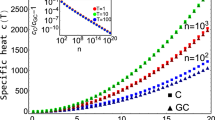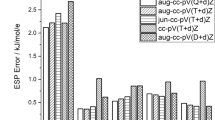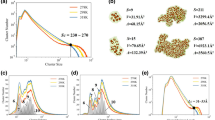Abstract
Energy landscapes hold the key to understanding a wide range of molecular phenomena. The problem of how a denatured protein re-folds to its active state (Levinthal's parado1) has been addressed in terms of the underlying energy landscape2,3,4,5,6,7, as has the widely used ‘strong’ and ‘fragile’ classification of liquids8,9. Here we show how three archetypal energy landscapes for clusters of atoms or molecules can be characterized in terms of the disconnectivity graphs10 of their energy minima—that is, in terms of the pathways that connect minima at different threshold energies. First we consider a cluster of 38 Lennard–Jones particles, whose energy landscape is a ‘double funnel’ on which relaxation to the global minimum is diverted into a set of competing structures. Then we characterize the energy landscape associated with the annealing of C60 cages to buckministerfullerene, and show that it provides experimentally accessible clues to the relaxation pathway. Finally we show a very different landscape morphology, that of a model water cluster (H2O)20, and show how it exhibits features expected for a ‘strong’ liquid. These three examples do not exhaust the possibilities, and might constitute substructures of still more complex landscapes.
This is a preview of subscription content, access via your institution
Access options
Subscribe to this journal
Receive 51 print issues and online access
$199.00 per year
only $3.90 per issue
Buy this article
- Purchase on Springer Link
- Instant access to full article PDF
Prices may be subject to local taxes which are calculated during checkout





Similar content being viewed by others
References
Levinthal, C. in Mössbauer Spectroscopy in Biological Systems, Proceedings of a Meeting Held at Allerton House, Monticello, Illinois(eds DeBrunner, J. T. P. & Muck, E.) 22–24 (Univ. Illinois Press, Urbana, (1969)).
Ball, K. D. et al. From topography to dynamics on multidimensional potential energy surfaces of atomic clusters. Science 271, 963–966 (1996).
Wales, D. J. Tales from topographic potential surfaces. Science 271, 925–929 (1996).
Bryngelson, J. D., Onuchic, J. N., Socci, N. D. & Wolynes, P. G. Funnels, pathways, and the energy landscape of protein folding: a synthesis. Proteins 21, 167–195 (1995).
Doye, J. P. K. & Wales, D. J. On potential energy surfaces and relaxation to the global minimum. J. Chem. Phys. 105, 8428–8445 (1996).
Wolynes, P. G. Symmetry and the energy landscapes of biomolecules. Proc. Natl Acad. Sci. USA 93, 14249–14255 (1996).
Berry, R. S., Elmaci, N., Rose, J. P. & Vekhter, B. Linking topography of its potential surface with the dynamics of folding of a protein model. Proc. Natl Acad. Sci. USA 94, 9520–9524 (1997).
Angell, C. A. Formation of glasses from liquids and biopolymers. Science 267, 1924–1935 (1995).
Stillinger, F. H. Atopographic view of supercooled liquids and glass formation. Science 267, 1935–1939 (1995).
Becker, O. M. & Karplus, M. The topology of multidimensional potential energy surfaces: theory and application to peptide structure and kinetics. J. Chem. Phys. 106, 1495–1517 (1997).
Wales, D. J. & Doye, J. P. K. Global optimization by basin-hopping and the lowest energy structuresof Lennard–Jones clusters containing up to 110 atoms. J. Phys. Chem. A 101, 5111–5116 (1997).
Doye, J. P. K. & Wales, D. J. Surveying a potential energy surface by eigenvector-following. Z. Phys. D 40, 194–197 (1997).
Kroto, H. W. Space, stars, C60, and soot. Science 242, 1139–1135 (1988).
Heath, J. R., O'Brien, S. C., Curl, R. F., Kroto, H. W. & Smalley, R. E. Carbon condensation. Comments Cond. Mat. Phys. 13, 119–141 (1987).
Heath, J. R. in Fullerenes—Synthesis, Properties, and Chemistry of Large Carbon Clusters(eds Hammond, G. S. & Kuck, V. J.) 1–22 (ACS Symp. Ser. 481, Am. Chem. Soc., Washington DC, (1992)).
Smalley, R. E. Self-assembly of the fullerenes. Acc. Chem. Res. 25, 98–105 (1992).
Endo, M. & Kroto, H. W. Formation of carbon nanofibers. J. Phys. Chem. 96, 6941–6944 (1992).
Murry, R. L., Strout, D. L., Odom, G. K. & Scuseria, G. E. Role of sp3 carbon and 7-membered rings in fullerene annealing and fragmentation. Nature 366, 665–667 (1993).
Manopoulos, D. E. & Fowler, P. W. in The Far-reaching Impact of the Discovery of C60 (ed. Andreoni, W.) 51–69 (NATO ASI Ser. E 316, Kluwer, Dordrecht, (1993)).
Strout, D. L. & Scuseria, G. E. Acycloaddition model for fullerene formation. J. Phys. Chem. 100, 6492–6498 (1996).
Marcos, P. A., López, M. J., Rubio, A. & Alonso, J. A. Thermal road for fullerene annealing. Chem. Phys. Lett. 273, 367–370 (1997).
Ballone, P. & Milani, P. Simulated annealing of carbon clusters. Phys. Rev. B 42, 3201–3204 (1990).
Chelikowsky, J. R. Nucleation of C60clusters. Phys. Rev. Lett. 67, 2970–2973 (1991).
Chelikowsky, J. R. Formation of C60clusters via Langevin molecular-dynamics. Phys. Rev. B 45, 12062–12070 (1992).
Jing, X. D. & Chelikowsky, J. R. Nucleation of carbon clusters via an accretion model. Phys. Rev. B 46, 5028–5031 (1992).
Wang, C. Z., Xu, C. H., Chan, C. T. & Ho, K. M. Distintegration and formation of C60. J. Phys. Chem. 96, 3563–3565 (1992).
Yi, J. Y. & Bernholc, J. Reactivity, stability, and formation of fullerenes. Phys. Rev. B 48, 5724–5727 (1993).
Xu, C. H. & Scuseria, G. E. Tight-binding molecular-dynamics simulations of fullerene annealing and fragmentation. Phys. Rev. Lett. 72, 669–672 (1994).
Maruyama, S. & Yamaguchi, Y. Amolecular dynamics demonstration of annealing to a perfect C60structure. Chem. Phys. Lett. 286, 343–349 (1998).
Porezag, D., Frauenheim, T., Seifert, G. & Kaschner, R. Construction of tight-binding-like potentials on the basis of density-functional theory—application to carbon. Phys. Rev. B 51, 12947–12957 (1995).
Austin, S. J., Fowler, P. W., Manolopoulos, D. E., Orlandi, G. & Zerbetto, F. Structural motifs and the stability of fullerenes. J. Phys. Chem. 99, 8076–8081 (1995).
Austin, S. J., Fowler, P. W., Manolopoulos, D. E. & Zerbetto, F. The Stone–Wales map for C60. Chem. Phys. Lett. 235, 146–151 (1995).
Stone, A. J. & Wales, D. J. Theoretical studies of icosahedral C60and some related species. Chem. Phys. Lett. 128, 501–503 (1986).
Scuseria, G. E. Ab-initio calculations of fullerenes. Science 271, 942–945 (1996).
Baker, J. & Fowler, P. W. Energetics of the Stone–Wales pyracylene transformation. J. Chem. Soc., Perkin Trans. 2, 1665–1666 (1992).
Zhang, Q. L. et al. Reactivity of large carbon clusters—spheroidal carbon shells and their possible relevance to the formation and morphology of soot. J. Phys. Chem. 90, 525–528 (1986).
Krätschmer, W., Lamb, L. D., Fostiropoulos, K. & Huffman, D. R. Solid C60—a new form of carbon. Nature 347, 354–358 (1990).
Jorgensen, W. L. Quantum and statistical mechanical studies of liquids. 24. Revised TIPS for simulations of liquid water and aqueous-solutions. J. Chem. Phys. 77, 4156–4163 (1982).
Wales, D. J. & Hodges, M. P. Global minima of water clusters (H2O)n, n ≤ 21, described by an empirical potential. Chem. Phys. Lett. 286, 65–72 (1998).
Angell, C. A. Relaxation in liquids, polymers and plastic crystals—strong fragile patterns and problems. J. Non-Cryst. Solids 131–133;, 13–31 (1991).
Acknowledgements
We thank J. P. K. Doye and A. J. Stone for discussions. D.J.W., M.A.M. and T.R.W. thank the Royal Society, the EPSRC and the Cambridge Commonwealth Trust, respectively, for financial support.
Author information
Authors and Affiliations
Corresponding author
Rights and permissions
About this article
Cite this article
Wales, D., Miller, M. & Walsh, T. Archetypal energy landscapes. Nature 394, 758–760 (1998). https://doi.org/10.1038/29487
Received:
Accepted:
Issue Date:
DOI: https://doi.org/10.1038/29487
Comments
By submitting a comment you agree to abide by our Terms and Community Guidelines. If you find something abusive or that does not comply with our terms or guidelines please flag it as inappropriate.



